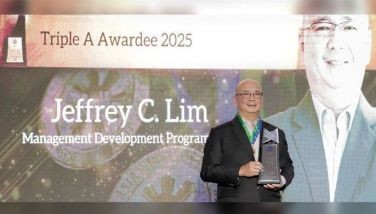The Philippine text messaging phenomenon
 (I am pleased to surrender my column space to my only daughter Michelle Lichauco. I have just found out that a very recent paper she submitted at Harvard assesses the impact of text messaging on the Filipino psyche. It is herein being reproduced.)
(I am pleased to surrender my column space to my only daughter Michelle Lichauco. I have just found out that a very recent paper she submitted at Harvard assesses the impact of text messaging on the Filipino psyche. It is herein being reproduced.)
It is the height of Manila traffic. The heat and smog outside are almost unbearable. But inside air-conditioned cars, crowded buses and jeepneys, commuters sit with their heads bowed. No, not in prayer or a moment of silence. Their hands are clutching cellular phones and their nimble thumbs are typing away at tiny alphanumeric keys, sending messages to friends, family, colleagues – even mass messages calling for the ouster of a president. In one car, a teenager may be typing sweet love messages or secret notes to friends. In another, a mother may be frantically trying to get in touch with her daughter’s school to notify them she would be late in picking up her child. In a restaurant, people sit at tables hardly talking to each other but instead are engrossed typing out messages on their cell phones. Nonstop beeping, an alert for incoming messages, sends a mad scramble for phones in pockets, backpacks, bags and briefcases. In malls, shoppers walk around with cell phones in hand, mastering the art of walking without looking ahead. Far away in the province, soldiers fighting insurgents in the mountains send messages to their families reporting their safety.
This is the Philippines, the text messaging capital of the world, where SMS (Short Message Service) has given rise to a subculture with its own lingo, folklore and etiquette. Fact is, in the Philippines, the words "I will call you" have been replaced by "I will text you."
More than 30 million text messages are transmitted daily, twice as many as in all of Europe. The popularity of the medium is jacking up cell phone sales.
There are only over a million personal computers vis-a-vis the current population of 79 million Filipinos, according to the International Telecommunications Union. The Philippine Internet Service Organization estimates that there are 400,000 Internet service subscribers in the Philippines. This includes a mixture of multi-user accounts, use of pre-paid Internet access, Internet cafes, corporate facilities, schools, etc. Total number of users in the Philippines has been estimated at around 2 million or 2.5 percent of the population as of 2000. (Source: http://www.digitalfilipino.com/)
Cellular mobile phone services began in the country only in 1991 and since then, the rise in the number of subscribers has been remarkable. As against 2 million Internet subscribers, there are 4.5 million mobile phone users in the Philippines, more than fixed line subscribers. (Source: http://www.nandotimes.com). As of May 2000, the number of cellular phone subscribers in the Philippines far exceeded the 3 million fixed line subscribers. (Source: National Telecommunications Commission, 2000). The wide popularity of wireless service is due to the spotty telephone service and the high costs of fixed line subscriptions. High installation charges and monthly fees for a telephone line have made fixed lines out of reach for most people and texting via cellular phone has become a more affordable way to keep in touch. The Philippines has become by far the global capital of text messaging, a feature of digital cell phones which has been ignored in many other countries.
SMS has taken off dramatically in the Philippines because of the affordability of the service compared to expensive Internet access on the computer. With the introduction of pre-paid accounts with no monthly fees or need for credit history, the service became even more affordable and accessible to people. Text messaging first appeared as a free feature of the mobile phone service and because Filipinos love a bargain, it became a craze. And it became even hotter, even now that the text messaging service is no longer free. But P1 per text message is still very cheap.
The extraordinary popularity of text messaging in the Philippines has spawned a subculture the media has dubbed Generation Txt. Teenagers and young upwardly mobile professionals have developed their own text language. To save on space (one is allotted only 164 characters per text), texters have developed their own abbreviated vocabulary to express themselves complete with "emoticons," a combination of symbols and punctuations that add up (with a lot of imagination and head tilting) to little faces that characterize expressions of happiness, anguish, confusion, disgust, embarrassment, and a host of other emotions. Thus, if you wanted to say, "I’ll be late. Could you save a seat for me? Thank you," in text language, that would be, "ILBL8. :( C%d u sav a sit 4 me? THNQ! :)"
|
|
Last January, Filipinos took text messaging to a different level when they ousted President Joseph Estrada. During the peaceful Edsa Revolution in 1986, cell phones did not exist yet. The late dictator Ferdinand Marcos was toppled by activists using radio broadcasts, placards and fliers.
It was fascinating to watch People Power 2 staged with the use of the powerful medium of text messaging. With protesters armed with powerful Internet mass mailings and Wed-linked mobile phones, the pace of events that led to President Estrada’s ouster, preceded by an impeachment trial in December, was incredible. Even before the impeachment trial, Estrada was already on trial in the court of public opinion. There were over 200 websites dedicated to the anti-Estrada campaign, ranging from lighthearted jokes and cartoons to more serious stuff like a signature campaign demanding his resignation. Snippets on Estrada’s lavish lifestyle, massive accumulation of wealth, his mistresses and the mansions he built for them, his all-night drinking sprees with cronies that left him unable to govern were passed on through text messaging. Every cell phone became a transmitter. Fliers and underground newspapers were replaced by real-time information campaign that made the younger population more politically aware and more active in the campaign that eventually overthrew Estrada. The volume of SMS jumped from 30 million messages a day to record levels of 70 million during the last days of the impeachment trial and EDSA 2. (Source: http://ww.time.com).
I remember my own experience with the power of this real-time messaging service. At the height of Estrada’s impeachment trial, a series of bombings racked the capital on a single day at over six different locations. Among those affected were the airport, a passenger bus, a mall and a gas station. We were on our way to my best friend’s wedding when the grim news reached us. Instantly, people received messages on their cell phones to avoid public places. The advisory, true or not, exact or exaggerated, must have saved more lives than we know. All throughout the wedding rites, news and updates were delivered via cell phones. Advisories on which road or main highway to avoid were passed on. People were able to monitor current happenings through a medium that allowed them to be active participants. Text messaging provided people easy access to instant information at a time when no information would have meant panic and chaos.
Aware of the power the medium wields, country’s new leader, President Gloria Macapagal-Arroyo, started using text messaging to give people better access to her office. Yes, you can text the President now. A list of numbers was published in the newspapers for people to use to text their views or grievances to the President. Even political talk shows let people to text in messages and air their opinions live on TV. It’s all about increasing Filipinos’ access to news and information and giving them a medium to be more active participants in a maturing democracy.
|
|
Last Monday, Filipinos trooped to the polls to elect senators, congressmen and local public officials. Internet and mobile communications were part of a candidate’s cache of campaign materials. Text brigades were set up by candidates to pass on theri slogans and platforms to voters.
The National Movement for Free Elections (NAMFREL) implemented voter education campaigns to be delivered through mobile phones and the Internet. These mass education campaigns were able to reach more voters, even in outlying areas, at lower costs. The non-profit organization has also set up its own text brigades made up of volunteers who send out information for forwarding to other people. The two main cellular operators in the Philippines, Globe Telecom and Smart Communications, have included quick count updates in their information-on-demand services since vote counting started. (Source:http://itmatters.bworld online.com)
|
|
Culturally, there are many reasons for the popularity of the SMS in the Philippines. We have a sense of community that drives us to stay connected. We just love keeping in touch and SMS via cell phones allows people to do so. From the young student to the busy professional, from the housewife to the policeman in the street, from farmer to soldier in a remote rural area, text messaging is the way to connect.
We are known to be an expressive people and this is just another vehicle for us to do just that. It is interesting to note how text messaging has given people a medium through which to express themselves but in a nonconfrontational way that is typically Filipino. Josephine Aguilar, a sociology professor at the University of Santo tomas, says it’s a way for people to convey messages that may not be easily said in Asia’s predominantly Catholic nation. Text messages on the phone are a high-technology veil, protective yet provocative. This nonconfrontational nature has also made the service a hit in Indonesia where politeness calls for ambiguity. The same is also true in Japan where NTT DoCoMo has 7.3 million customers using the Web on mobile phones. (Source:http://ww.text.it)
|
|
But just like any form of technology, text messaging has its drawbacks. It has proven to be one of the top driving hazards in a country where traffic jams are part of the people’s daily lives. Educators have stressed the implications of the texting culture on the educational formation of the Filipino youth. With the advance of technology comes a "de-skilling" which has implications in the educational and professional settings. With so much practice and ease in abbreviating their thoughts in messages, students hand in compositions using very simple words and the same abbreviated language so common in text messages. Cell phones have been banned in schools by the Department of Education, Culture and Sports because of the cheating and distraction that have resulted from their use. Parents are also concerned about the obscene and malicious text messages that are passed around without any form of supervision or screening. The National Telecommunications Commission says it has been flooded with complaints about obscene, malicious and subversive text messages. Candidates in this month’s elections have also complained about being victims of offensive and libelous text messages. (Source:http://ananova.com). But it is the freedom of expression afforded by this technology that has made it such a phenomenon among teenagers and young professionals. (To be continued)



















